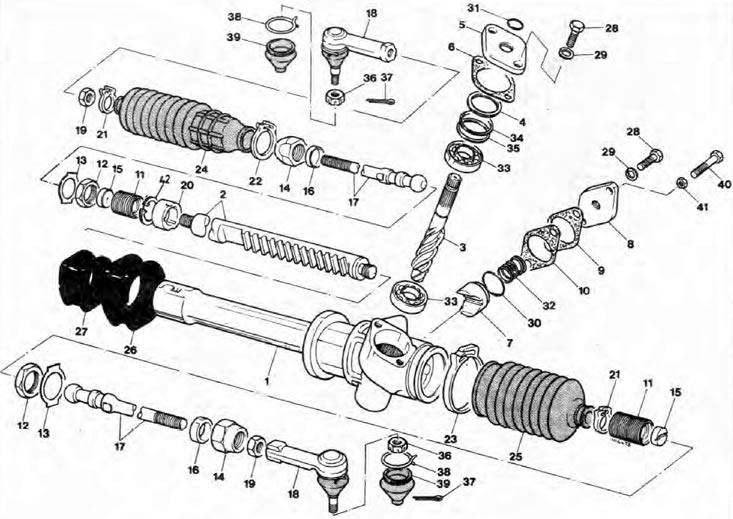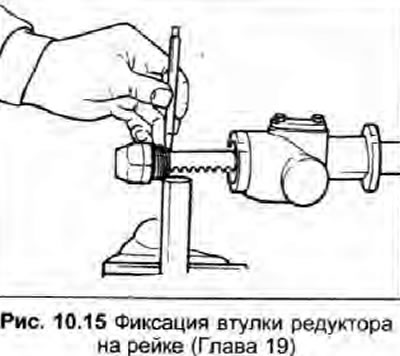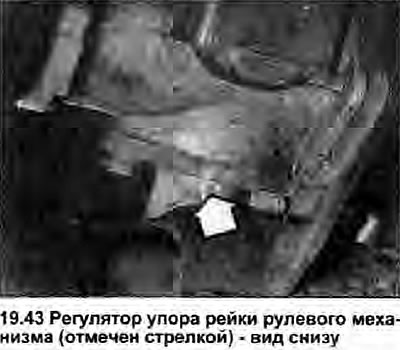
Pic. 10.14. Steering components
1. Steering gear housing; 2. Rail; 3. Gear; 4. Spacer (if available); 5. Gear cover; 6. Gasket; 7. Resistant heel; V. Thrust heel cover; 9. Gasket; 10. Gasket (If you want to); 11. Reducer sleeve; 12. Locknut; 13. Lock washer; 14. Clutch bushing; 15. Nest; 16. Insert; 17. Tie rod; 18. Tie rod ball joint; 19. Ball joint locknut; 20. Rail bushing; 21. External bracket of the protective cover; 22. Inner bracket of the protective cover (left); 23. Inner bracket of the protective cover (right); 24. Left rubber protective cover of the steering mechanism; 25. Right rubber protective cover of the steering mechanism; 26. Mounting rubber bushing of the steering mechanism; 27. Mounting rubber bushing of the steering mechanism; 28. Bolt; 29. Washer; 30. O-ring; 31. Oil seal (o-ring); 32. Spring; 33. Bearing; 34. Gasket (If you want to); 35. Gasket (If you want to); 36. Nut; 37. Hairpin; 38. Retaining ring; 39. Dust cap; 40. Thrust heel adjuster; 41. Locknut; 42. Retaining ring.
Note: Before you start overhauling the steering gear, check the price and availability of individual components, as well as the prices of a new or already remanufactured unit, as overhaul may not be economically viable. Also read the procedure carefully and prepare all the necessary tools
Disassembly
1. Remove the steering gear from the car (Chapter 18).
2. Thoroughly clean the assembly, prepare a clean work surface and keep clean. Gently clamp the steering gear in a soft-grip vise. Remove the dust cap from the gear shaft, then release the brackets and remove the rubber protective boots from the casing.

3. First, set the steering rack exactly at the middle of the travel, which will correspond to the position of the wheels for driving straight ahead. Then proceed as follows.
4. Rotate the gear until the rack reaches its maximum length on one side and measure the distance between the tie rod ball joint and a specific point on the casing. Move the staff in the opposite direction, and again measure the distance between the same two points. The difference between these two dimensions will be equal to the full travel of the rack; divide the travel by two and move the rail this distance, it should be in the center of the casing, also check that the dimensions shown in fig. 10.16.

5. Remove the tie rod ball joints and their locknuts (Chapter 20), then pull off the rubber protective covers; drain all the oil. Store the right and left side components in separate containers. These components are recommended to be installed only in their original place (although some can be installed on either side, do not confuse them when assembling).
6. Using an electric drill or similar tool, loosen the gear bushing at each end of the rack. While holding the bushing jam nut with a wrench, unscrew the gearbox bushings and separate the tie rods from the rack.
7. Using a screwdriver, pry off the lock washer tabs and remove the bushings from the lock nuts, then disassemble all components of each tie rod assembly.
8. Unscrew the rail stop cover from the casing, noting the number of gaskets under it. Remove the spring, shift the rack stop, and remove it by grasping the hole for the rack stop spring with circlip pliers. Remove and discard the rack stop O-ring.
9. Unscrew the gear cover from the casing. Remove the cover, noting the gaskets underneath. On early models, the cover consists of a mounting plate and a cover with an O-ring between them; on later models, the cover is also the gland housing.
10. Remove the pinion shaft with the top bearing. To do this, clamp the shaft in a soft-grip vise and tap gently on the top side of the casing.
11. The pinion shaft lower bearing can be removed with a bearing puller. If the upper bearing is to be replaced, use a suitable tool to remove it from the pinion shaft.
12. Remove the rack, then from the left end of the casing, remove the retaining ring and the rack support sleeve, remember that the sleeve has mounting tabs that must fit into the corresponding recesses in the gear housing.
Inspection
13. Thoroughly clean all components of dirt and old grease, and replace worn or damaged ones. While rolling the rack on a flat surface, check it for distortion, then check the teeth on the rack and pinion. Check all bearings, bushings and running surfaces for signs of wear. Replace all gaskets, seals, lock washers and gearbox bushings whenever the mechanism is disassembled.
14. When assembling, carefully coat all components as specified in Specifications lubricant; and fill the steering box and protective covers with it.
Assembly
15. Install the rack bushing and secure it with a new circlip.
16. To accurately install the gear and bearings, a special tool in the form of a blunt tubular drift, MP 7-108, is used. If this tool is not available, the procedure described below in paragraphs 17, 18 and 19 can be used; note that if the housing is slightly warmed first, the bearings will slide easily into the holes and be properly seated with minimal risk of damage. Also, excessive force will not be required.
17. Hammer the new lower gear bearing into the casing until it stops, using a hammer and a tubular drift, which should rest against the outer ring of the bearing.
18. Push the new top bearing onto the pinion shaft until the inner race contacts the pinion teeth. To do this, use a hammer and a tubular drift, which should rest against the inner ring of the bearing.
19. Drive the gear with the upper bearing into the housing until the lower bearing inner race contacts the gear teeth. To do this, use a hammer and a tubular drift, which should rest against the outer ring of the upper bearing, and make sure that the lower end of the gear is not warped into the lower bearing. Lubricate gear components.
20. Lubricate the rack and install it in place, make sure that the teeth of the rack and gear are properly engaged; center the rack in the casing so that it is located in the middle of the stroke (see point 4 above).
21. Fix a new gasket to the contact surface of the gear cover with grease, then measure the distance from the upper bearing inner race to the top side of the gasket. Select spacers so that their total thickness equals the measured distance (maximum tolerance +0.10 mm) - there are gaskets with a thickness of 0.10 and 0.20 mm.
22. Install all gaskets, then install cover components, and apply a few drops of sealant to cover bolt threads. Tighten the bolts with a torque specified specifications.
23. Move the rail from one extreme position to another. Its course should be smooth, without jerks and gear backlash. Return the rack to the middle position.
24. Lubricate the hole in the casing and the stop of the rail, install the stop and firmly press it to the rail: there should be no play between the rail and the stop. Install a new O-ring into the rack stop groove, then install the spring. Install the cover using a new gasket. Loosen the adjuster lock nut, and unscrew the adjuster so that there is no pressure on the rack other than the rack stop and spring.
25. Using a steelyard, measure the force required to move the rack back and forth. Take the measurement three times and calculate the average; the regulated value is 110-130 N. If the measured force is less than 110 N, replace the spring and repeat the measurement: if more than 130 N, install another gasket between the cover gasket and the casing - a gasket with a thickness of 0.2 mm reduces the force by 20 N.
26. Lubricate rack stop components and install stop cover with all selected gaskets. Tighten the cover bolts with a tightening torque specified specifications.
27. With the rail in the middle position, gently tighten the regulator by hand until you feel steady pressure; in this position, all play between the rack stop, rack and pinion must be eliminated. Loosen the adjuster 30°, apply a few drops of sealant to the threads, and while holding it from turning, tighten the locknut securely. Once again check that the rail moves from one extreme position to the other easily and without jerks, then return it to the middle position.
28. Screw new gearbox bushings onto each end of the rack, then temporarily install and tighten coupling bushings and locknuts onto them. Clamp one end of the coupling sleeve and locknut in a vise, tighten both reducer sleeves (by installing the socket on the opposite sleeve of the coupling) tightening force, regulated specifications. Fix the gearbox bushings by bending their edge into the groove at the end of the rail.
29. Unscrew the coupling bushings, and attach the tie rods to them, installing new lock washers and covering with lithium grease the contact surfaces of the spherical pins, their sockets and inserts. To attach the tie rod to the rack, first tighten the clutch bushing by hand.
30. Put on the rubber protective boots on the steering rods, then install the locknuts and ball joints on the rods.
31. Screw the ball joint into the tie rod until the distance from the outer edge of the boot groove to the center of the ball joint is as shown in Fig. 10.16, then lightly tighten the locknut of each ball joint; check that the distance from the outer edge of the protective boot groove to the inner edge of the locknut is as shown in Fig. 10.16. Notice that the marks made when you unchecked should now line up.
32. Check that the distance between the centers of the two ball joints of the tie rods is as shown in Fig. 10.16. If it is necessary to change the position of the ball joints to correct this value, make sure that each of them is screwed in by the same number of turns; the final distance between the tie rod to the center of the ball joint/lock nut on both sides must always be the same, but a deviation of up to 3 mm from the value shown is allowed.
Note: This is only the basic setting, the final toe setting is done with the steering gear installed in the vehicle.
33. If the car needs to be rolled in to check the wheel alignment, securely tighten the locknuts of the ball joints; otherwise, follow Chapter 21.
34. Clamp the cover in a soft-grip vise, hook the steelyard into the notch for the dust cap of the ball joint, clamp the coupling sleeve with a force of 12.5-20.5 N. Then, holding the coupling sleeve stationary, securely tighten the lock nut. Lock the assembly by bending the tabs of the lock washer onto the lock nut and onto the coupling sleeve, then repeat the procedure on the remaining tie rod.
35. Make sure the rail is in the middle position (centered in the casing), then use white paint to make alignment marks on the pinion shaft and housing so that when installing the steering gear in the car, the middle position of the rack can be easily determined. Install the dust cap on the gear shaft and make sure the pins of both ball joints are facing down (those. in the correct position for installation in the car).
36. If the steering mechanism is filled with grease, position the rubber boots in the grooves on the steering rods and secure with the outer brackets, then fill the remaining grease into the protective boots, place them in the grooves in the casing and secure with the inner brackets.
37. If the steering mechanism is filled with oil, first install one rubber protective boot and secure it with brackets, then position the other protective boot in the groove of the casing and secure with the inner bracket. Introduce the remaining oil under the sealing lip of the protective boot and into the steering gear, and secure the outer bracket.
38. Install the steering gear in the car (Chapter 18). If any of the tie rods need to be rotated, loosen the cleats and reposition the protective boot, then secure the cleats taking care not to lose lubrication.
Final adjustment of the rail stop
39. Every time after a violation of the position, or in the event of a malfunction of the steering mechanism, check the installation of the rack stop as follows.
40. First make sure the tires are in good condition and the pressure in them is correct, and that the brakes do not block the wheels.
41 Drive in a straight line, release the steering wheel and check that the vehicle continues to move straight ahead.
42. Slightly turning the steering wheel from the middle position in any direction (approximately 20°), make sure it returns to the straight ahead position when released.
43. If self-centering is slow or stiff, adjust the rack stop as described above. Note however that it may be necessary to remove the steering gear from the vehicle as the adjuster is difficult to access (see photo).

